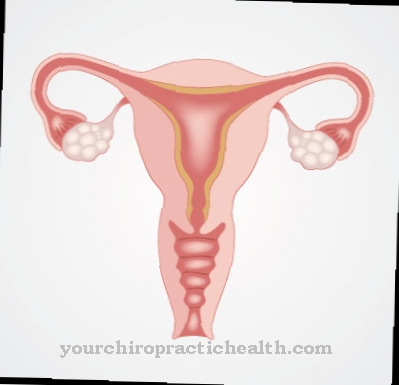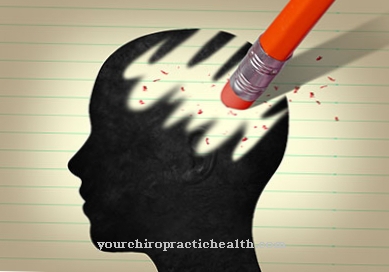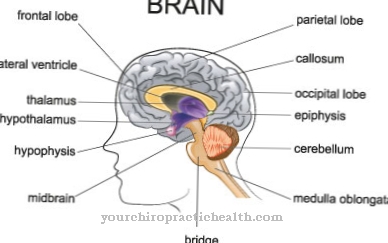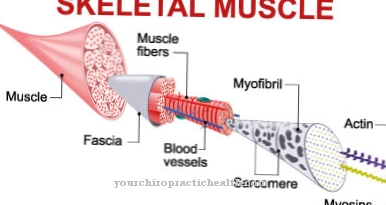The Kauda Syndrome (also Cauda Syndrome called) denotes a crushing of the nerves in the area of the cauda equina. It is often associated with a severe herniated disc and, when the typical symptoms occur, requires immediate action to decompress the bruised nerves and avert more serious consequences such as paralysis.
What is Kauda Syndrome?

© Idey - stock.adobe.com
The Kauda Syndrome describes the symptoms and clinical pictures that are related to a squeezing of the sensitive nerves in the lower part of the spinal cord, the so-called "cauda equina".
This results in pain in the lumbar spine, which radiates into one leg or even both legs down to the lower legs, and severe bladder pain, which increases when the body pressure increases (e.g. when sneezing or coughing). Kauda syndrome is known as breeches anesthesia, which means that the anal area and the inner thigh area become numb.
Impotence is another symptom of Kauda Syndrome. Often control over emptying the bowel and bladder is lost, and the rectal exam reveals a relaxed sphincter. The legs become weak, in many cases a real weakness of the dorsiflexion of the foot is determined, and the mechanical reflexes of the leg (for example hamstring reflexes) no longer function properly or not at all.
causes
Trigger of the Kauda Syndrome is always damage to the sensitive nerves in the lower spine, which is caused by a (usually long-lasting) contusion.
The squeezing of the nerves leading to cauda equina syndrome can in turn be caused by various triggers. On the one hand, it can be a particularly severe herniated disc, on the other hand, metastases in the lower spine can be responsible for the damage.
A bone injury, individual vertebrae being pushed out, which then press on the nerve fiber complex, or a vertebral fracture are also possible causes.Tragically, however, in some cases surgical interventions lead to the typical bruising of the nerve fibers, which then cause cauda equina syndrome.
Symptoms, ailments & signs
Kauda syndrome manifests itself in its course through a number of symptoms and complaints that appear suddenly and lead to chronic disorders within a short time. Most people initially experience unspecific back pain or sensitivity disorders in the lower back. Often there are also symptoms of paralysis of the arms and legs. If the bruise is not treated immediately, permanent paralysis can set in.
The entrapment of the nerves can also cause loss of control of the bladder and bowel. The patients usually develop a chronic pain syndrome, which significantly limits their quality of life. The Kauda syndrome is usually acute. It is often preceded by a severe herniated disc, bone injury or metastasis.
The syndrome cannot be seen externally. However, as the disease progresses, it can lead to poor posture, restricted mobility and other symptoms that are externally visible. If the Kauda syndrome occurs during an operation, the symptoms appear suddenly and quickly increase in intensity. If treatment is missing or too late, the nerves are permanently damaged. This can lead to incontinence, circulatory disorders and in the worst case to paraplegia.
Diagnosis & course
The Kauda Syndrome is one of the most dangerous diseases that can occur in humans and must be treated immediately. If the squeezed nerve fibers are not surgically decompressed within the first six hours after the onset of the typical symptoms, the symptoms (e.g. paralysis and sensory disturbances in the legs and loss of control over the bladder and bowel) usually become chronic and can only develop in rare exceptional cases partially regress.
The diagnosis of cauda equina syndrome therefore plays a central role. As soon as signs of cauda equina syndrome appear, the diagnosis must be made immediately. For the diagnosis, neurological examinations (for example checking the Achilles tendon or patellar tendon reflex, checking the sensitivity in the affected regions and the sphincter muscle) in conjunction with imaging methods such as computed tomography or MRI are possible. Once diagnosed, cauda equina syndrome must be treated immediately.
Complications
In most cases, cauda equina syndrome occurs in connection with a herniated disc. This leads to considerable restrictions in movement and in the patient's everyday life. If treatment is not taken immediately, the nerves can be irreversibly damaged under certain circumstances, so that there are significant restrictions in the patient's life.
The pinching of nerves usually leads to paralysis or various disorders of sensitivity. Those affected suffer from considerable back pain and severe paralysis in the legs. It is not uncommon for patients to rely on a wheelchair and on the help of other people in their everyday lives. The paralysis can also lead to considerable psychological complaints or depression.
It is not uncommon for those affected to struggle with suicidal thoughts. The quality of life is significantly reduced by the Kauda syndrome. As a rule, treatment has to take place a few hours after the first appearance of the kauda syndrome. In doing so, nerves may not be saved.
If the initiation of treatment is delayed, irreversible damage usually occurs, so that patients suffer from lifelong limitations. However, life expectancy is not reduced by Kauda Syndrome.
When should you go to the doctor?
Sudden pain in the lower back is a warning from the organism. You must be examined and treated immediately so that the symptoms do not increase and no lifelong impairments develop. Abnormalities in the lumbar spine are considered worrying and should be clarified by a specialist. If the pain moves into the anal area of the person concerned, a doctor's visit is necessary immediately.
In the event of paralysis, restricted mobility or a loss of the usual physical performance level, a doctor is required for further examinations and the search for the cause of the symptoms. The affected person should take it easy immediately after the onset of pain and only perform slow movements until medical attention is given. Sensitivity disorders, numbness or hypersensitivity to touching the lower back should be examined and treated. If the back is bruised as a result of an accident, fall or physical assault, a doctor's visit is required.
The damaged region is examined in imaging procedures so that the necessary steps for medical care can be initiated. If there is also a disorder of potency in men, this symptom is alarming. A doctor must be seen as soon as possible. If discomfort occurs when emptying the bowel or kidney, a doctor's visit is also required.
Treatment & Therapy
When a Kauda Syndrome is diagnosed, neurosurgical intervention is indicated as soon as possible to decompress the nerve fibers affected by the bruise.
This procedure should be performed within six hours of the onset of one or more symptoms of Kauda Syndrome to avoid permanent damage to the nerves. If the procedure is too late and the bruise has already irreparably damaged the nerves, the symptoms of cauda equina syndrome do not regress, but remain chronic.
Those affected then suffer from symptoms of paralysis and numbness and usually lose control of the bladder and intestines. Only in very few cases can the stimulation of the damaged nerves lead to partial control of the affected body areas being regained.
You can find your medication here
➔ Medicines for back painOutlook & forecast
The prognosis of cauda equina syndrome depends on the triggering disorder. If the crushing of the nerves can be resolved by correcting the vertebrae with a few professional movements, the symptoms are usually relieved within a short time. If the bones are broken, bruised, or twisted, there is also a good chance of recovery. It takes some time to rest and rest and to monitor the regeneration process until an improvement is seen.
The course of the disease and the prognosis worsen when metastases have formed in the organism. If these are the causal reason responsible for the symptoms, cancer therapy must be given. The prospect of a cure depends on the stage of the cancer. In severe cases and with advanced development, the patient is at risk of premature death.
If the herniated disc is particularly severe, the prognosis is also worsened. Surgical intervention can improve health. Surgery is associated with various risks and side effects. In addition, different complications can occur in the further healing process, which have an impact on the prognosis of the cauda equina syndrome. There is a possibility of a chronic course of the disease. This leads to a considerable reduction in the quality of life and coping with everyday life and can trigger psychological secondary diseases.
prevention
An effective prevention against that Kauda Syndrome is currently unknown. However, it certainly makes sense to be physically active, not to weigh too much, and to have strong core muscles to minimize the chances of having a herniated disc. However, it is and will remain the key to seek immediate medical help the first time symptoms of cauda equina syndrome appear - and thus at least to prevent the symptoms of cauda equina syndrome from becoming chronic.
Aftercare
In most cases, follow-up measures for cauda equina syndrome are very limited. First and foremost, the person affected should consult a doctor very early so that no further complications or complaints occur. Only through early detection of the disease can a further worsening of the symptoms be prevented.
Ideally, those affected should have consulted a doctor at the first sign of the Kauda Syndrome. Self-healing cannot occur with this disease. In the case of this disease, an immediate surgical intervention usually has to take place so that the person concerned does not become permanently paralyzed. After such a procedure, strenuous, stressful or physical activities must be avoided at all costs.
Many patients are dependent on the help and support of their own family in their everyday life, whereby intensive and loving discussions can have a positive effect on the further course and also on the condition of the person concerned. Physiotherapy measures are also necessary, whereby many of the exercises from such therapy can also be repeated in your own home. Most of the time, Kauda Syndrome does not limit the life expectancy of the person affected.
You can do that yourself
Immediate action is required if Kauda syndrome occurs. The affected person should consult a doctor at the first symptoms and have the complaints clarified. If the bruise is treated early enough, the spine can be loaded again relatively quickly after the procedure. In the first two to three weeks, however, rest is indicated. Physical work, especially work that could stress the intervertebral discs, must be strictly avoided.
In addition to follow-up care, the causes of the bruising must be determined. Often the cause is a tumor that needs to be diagnosed and treated. If the Kauda syndrome is based on chronic malpositions, therapeutic measures are indicated. In most cases, the workload must also be reduced. If the bruise is treated too late, permanent nerve damage has usually already occurred. The resulting paralysis must be treated with physiotherapy. The most important self-help measure is to reduce the everyday restrictions through aids and a disabled-friendly facility.
Therapeutic advice helps the person affected to accept the new life situation. To support this, it makes sense to visit a self-help group, because dealing with a disability is much easier when talking to other affected people.








.jpg)



















